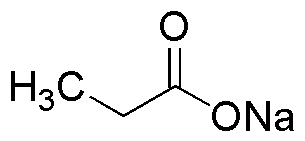Propionic acid sodium salt is widely utilized in research focused on:
- Food Preservation: This compound is commonly used as a preservative in baked goods and dairy products, helping to inhibit mold and bacterial growth, thereby extending shelf life.
- Animal Feed Additive: It serves as an effective feed additive in livestock and poultry, promoting gut health and improving feed efficiency, which is crucial for the agricultural industry.
- Pharmaceuticals: In the pharmaceutical sector, it is used as a buffering agent in various formulations, ensuring stability and optimal pH levels for drug efficacy.
- Biochemical Research: Researchers utilize it in cell culture and microbiological studies due to its role in metabolic pathways, aiding in the understanding of cellular processes.
- Cosmetic Formulations: This compound is also found in cosmetic products as a pH regulator, enhancing product stability and skin compatibility, which is important for consumer safety.
General Information
Properties
Safety and Regulations
Applications
Propionic acid sodium salt is widely utilized in research focused on:
- Food Preservation: This compound is commonly used as a preservative in baked goods and dairy products, helping to inhibit mold and bacterial growth, thereby extending shelf life.
- Animal Feed Additive: It serves as an effective feed additive in livestock and poultry, promoting gut health and improving feed efficiency, which is crucial for the agricultural industry.
- Pharmaceuticals: In the pharmaceutical sector, it is used as a buffering agent in various formulations, ensuring stability and optimal pH levels for drug efficacy.
- Biochemical Research: Researchers utilize it in cell culture and microbiological studies due to its role in metabolic pathways, aiding in the understanding of cellular processes.
- Cosmetic Formulations: This compound is also found in cosmetic products as a pH regulator, enhancing product stability and skin compatibility, which is important for consumer safety.
Documents
Safety Data Sheets (SDS)
The SDS provides comprehensive safety information on handling, storage, and disposal of the product.
Product Specification (PS)
The PS provides a comprehensive breakdown of the product’s properties, including chemical composition, physical state, purity, and storage requirements. It also details acceptable quality ranges and the product's intended applications.
Certificates of Analysis (COA)
Search for Certificates of Analysis (COA) by entering the products Lot Number. Lot and Batch Numbers can be found on a product’s label following the words ‘Lot’ or ‘Batch’.
*Catalog Number
*Lot Number
Certificates Of Origin (COO)
This COO confirms the country where the product was manufactured, and also details the materials and components used in it and whether it is derived from natural, synthetic, or other specific sources. This certificate may be required for customs, trade, and regulatory compliance.
*Catalog Number
*Lot Number
Safety Data Sheets (SDS)
The SDS provides comprehensive safety information on handling, storage, and disposal of the product.
DownloadProduct Specification (PS)
The PS provides a comprehensive breakdown of the product’s properties, including chemical composition, physical state, purity, and storage requirements. It also details acceptable quality ranges and the product's intended applications.
DownloadCertificates of Analysis (COA)
Search for Certificates of Analysis (COA) by entering the products Lot Number. Lot and Batch Numbers can be found on a product’s label following the words ‘Lot’ or ‘Batch’.
*Catalog Number
*Lot Number
Certificates Of Origin (COO)
This COO confirms the country where the product was manufactured, and also details the materials and components used in it and whether it is derived from natural, synthetic, or other specific sources. This certificate may be required for customs, trade, and regulatory compliance.


